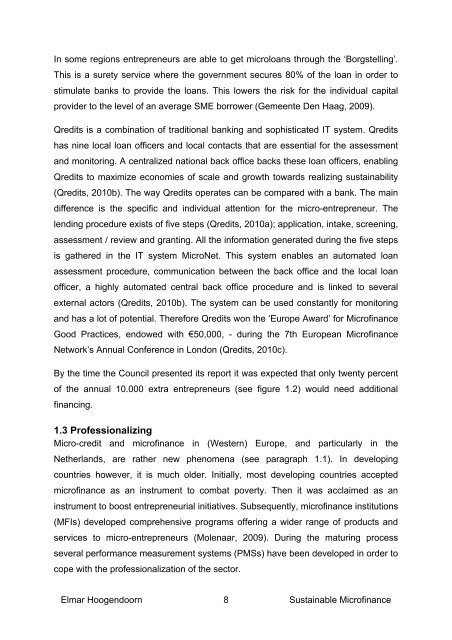Sustainable Microfinance - Balanced Scorecard's added value for ...
Sustainable Microfinance - Balanced Scorecard's added value for ...
Sustainable Microfinance - Balanced Scorecard's added value for ...
You also want an ePaper? Increase the reach of your titles
YUMPU automatically turns print PDFs into web optimized ePapers that Google loves.
In some regions entrepreneurs are able to get microloans through the ‘Borgstelling’.<br />
This is a surety service where the government secures 80% of the loan in order to<br />
stimulate banks to provide the loans. This lowers the risk <strong>for</strong> the individual capital<br />
provider to the level of an average SME borrower (Gemeente Den Haag, 2009).<br />
Qredits is a combination of traditional banking and sophisticated IT system. Qredits<br />
has nine local loan officers and local contacts that are essential <strong>for</strong> the assessment<br />
and monitoring. A centralized national back office backs these loan officers, enabling<br />
Qredits to maximize economies of scale and growth towards realizing sustainability<br />
(Qredits, 2010b). The way Qredits operates can be compared with a bank. The main<br />
difference is the specific and individual attention <strong>for</strong> the micro-entrepreneur. The<br />
lending procedure exists of five steps (Qredits, 2010a); application, intake, screening,<br />
assessment / review and granting. All the in<strong>for</strong>mation generated during the five steps<br />
is gathered in the IT system MicroNet. This system enables an automated loan<br />
assessment procedure, communication between the back office and the local loan<br />
officer, a highly automated central back office procedure and is linked to several<br />
external actors (Qredits, 2010b). The system can be used constantly <strong>for</strong> monitoring<br />
and has a lot of potential. There<strong>for</strong>e Qredits won the ‘Europe Award’ <strong>for</strong> <strong>Microfinance</strong><br />
Good Practices, endowed with !50,000, - during the 7th European <strong>Microfinance</strong><br />
Network’s Annual Conference in London (Qredits, 2010c).<br />
By the time the Council presented its report it was expected that only twenty percent<br />
of the annual 10.000 extra entrepreneurs (see figure 1.2) would need additional<br />
financing.<br />
1.3 Professionalizing<br />
Micro-credit and microfinance in (Western) Europe, and particularly in the<br />
Netherlands, are rather new phenomena (see paragraph 1.1). In developing<br />
countries however, it is much older. Initially, most developing countries accepted<br />
microfinance as an instrument to combat poverty. Then it was acclaimed as an<br />
instrument to boost entrepreneurial initiatives. Subsequently, microfinance institutions<br />
(MFIs) developed comprehensive programs offering a wider range of products and<br />
services to micro-entrepreneurs (Molenaar, 2009). During the maturing process<br />
several per<strong>for</strong>mance measurement systems (PMSs) have been developed in order to<br />
cope with the professionalization of the sector.<br />
Elmar Hoogendoorn 8<br />
<strong>Sustainable</strong> <strong>Microfinance</strong>
















![Joint Report on Social Protection and Social Inclusion [2005]](https://img.yumpu.com/19580638/1/190x132/joint-report-on-social-protection-and-social-inclusion-2005.jpg?quality=85)
